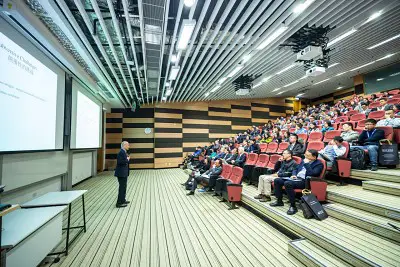An Engaging Business presentation? Read This!
You find yourself spending endless hours in tools like Microsoft Teams or Zoom or around a table discussing strategic agendas, busy schedules from beginning to end of the day with conversations about different projects. All this, not infrequently, leaves you exhausted.
However, it doesn’t have to be that way! The problem, mind you, is not the meetings themselves but the way they are planned and conducted. We’ve put together some tips to help those who already have their e-mail inbox full of appointments.
These are simple steps, but they can make your business communication a lot easier, instead of a source of problem-solving and advancing discussions, and not anguish and suffering. To find out more about it, please keep reading this article!
How to make an Engaging Business Presentation?
A business presentation must be planned and organized with time; when you decide to do one, it must communicate crucial information or share an idea with the stakeholders. Once you choose to move forward, bring data that can help develop the meeting, relevant facts, and subjects that can be addressed.
It is also essential that you have precision in the information directly concerning your performance, as you may be asked about something.
Below, you can see some actions that can help make these meetings more efficient:
- Assess the need for the meeting
Social networks are full of comments and memes about meetings that could have been e-mailed. Don’t be a joke! Before rushing to call an official conversation, think if you can’t resolve the matter in a few lines of e-mail or even in a few message exchanges through the company’s communication channel (Slack, Teams, and so many others).
Not every discussion deserves a meeting.
- Set a schedule
Suppose you have concluded by inviting some people to discuss the matter, including the topics covered in the schedule. It is essential that the person who organized the meeting knows your focus and, more importantly, that others are also aware. So they can prepare for the conversation and get straight to the point.
Planning what will be discussed at the meeting is essential so that important issues are not left out, and the arrangement does not take too long. The best thing about organizing a business presentation before is that both parties get to know what will be discussed and brainstorm ideas, thus multiplying the chances of successful communication.
Planning also makes the meeting more productive, as you won’t waste time trying to organize yourself amidst several possible topics; after all, each person’s time is precious and must be respected.
3. Take care of your self-image
As in almost all professional fields, it is critical to make a good impression in the business world.
Taking care of your self-image includes being prepared and coming up with good proposals and showing yourself dressed and groomed in a way that demonstrates how important the meeting is to you.
After all, if you show up with a scruffy term or an unshaven face, for example, your client will get the impression that the outcome of the meeting is of little importance to you. Consequently, no matter how good your work is during the session itself, the first impression will have already done severe damage.
4. Share information in advance
If the meeting concerns a project, the discussion of a document, or something that requires a prior preparation, share all the necessary material, and it’s no use being minutes before, give people enough time to be aware of the theme. You will gain speed and greater resolution power if everyone arrives properly informed, saving those minutes of presentation.
5. Summon the right people
Think about which colleagues are crucial to decision-making or sharing knowledge about the topic at hand. After all, who hasn’t dropped into a parachute meeting, walked out of it without knowing why they were there?
Reflecting on who the key professionals are for the meeting helps save everyone’s time.
6. Stipulate a time to start, but also to end
Sometimes, we enter a meeting without knowing when we will leave it. In addition to long periods of discussion not being efficient, as we begin to lose the ability to pay attention after a specific time, they can make the process less objective.
When we know the time set for the conversation, it disciplines us to focus and discuss what was proposed on the agenda.
7. Leave the meeting aware of the following steps
Every meeting must have a goal, which, as I explained above, must be shared before the conversation takes place. Therefore, an action plan must also be drawn up if there is a goal.
It does not necessarily need to be about something extremely robust and detailed at the level of strategic planning.
Still, a shortlist of next steps so that everyone knows what (or what) are the directions pointed out in the meeting. That is, what was its practical result.
8. Schedule breaks
Even with all the tips above, sometimes it will happen that, one day, a high load of meetings will be concentrated. If all of them have passed the above criteria and are necessary, consider reducing the time from one hour to 50 minutes, thinking that a ten-minute interval between them.
It’s that moment for us to drink some water, step away from the screen, and stretch our legs. A simple tip, but it already helps to reduce fatigue.
9. Show your differential
When trying to impress someone, you need to have a differential that attracts the person’s attention regardless of the situation. In the corporate world, it is no different; it is necessary to show what is unique about your presentation and make it more attractive in the commercial aspect.
For example, let’s say you are a small business owner. In this way, your business’s potential must be shown in your meeting.

Ways to Communicate Business Information
- Corporate E-mail
In the face of the technological revolution, corporate e-mail may seem outdated, but it is still widely used and has proven effective.
It is possible to transmit information to all interested parties through automatic triggers in an agile and simultaneous way.
In addition to being able to be accessed remotely, which is an excellent advantage as it provides mobility to employees without harming the receipt of information, it can be consulted at any time in case of forgetfulness.
In addition to transmitting information, such as notices of unforeseen events or news, e-mail can still be used to schedule and confirm participation in corporate meetings.
- Shared cloud drive
Documents, spreadsheets, text files, videos, slideshows. All these materials are used daily in all companies in various activities, carrying out the work itself and sharing relevant information.
Adopting shared drives in the cloud is interesting to ensure proper communication with the internal public safely and efficiently.
In the cloud, documents can be accessed remotely by several employees simultaneously and securely. Among the most common drives are Google Drive and Dropbox.
- Newsletter
The newsletter can be described as a company magazine, and it must contain well-crafted and relevant information actions to establish a connection between the company and employees.
In addition to the educational role, it promotes the appreciation of professionals.
It can be developed in printed or digital format and must be aesthetically pleasing and instigating to arouse employees’ attention and make them want to read the texts available.
The newsletter can also be used as a showcase for interviews with professionals, presentation of results, dissemination of organizational culture, and expression of future goals, among other purposes.
- Message Boards
This is one of the primary and most traditional tools, but it is still quite effective. The message board is the type of board to attach important notices.
It must be placed with a high flow of employees (near the electronic point, the drinking fountain, and other similar places).
The goal of a message board is to communicate about important events, such as meetings, training, or evaluations that require the presence of employees. In addition, it must be constantly updated. The bulletin board can be divided by areas or teams in larger companies.
- Intranet
An intranet is an internal computer network; it works like the internet, but privately and within the confines of the institution. However, intranet access is only allowed to the company’s employees or other authorized persons.
This tool aims to interconnect multiple company departments, even if they are physically separated. Thus, professionals have access to internal information more quickly, contributing to increased productivity. In addition, with the intranet, it is possible to make the virtual distribution of training, important announcements, performance reports, promotional materials, and others.
- Suggestion box
The suggestion box is another tool widely used in organizations. Its objective is to collect creative ideas to solve problems or optimize company activities. In internal communication, a suggestion box allows professionals who feel uncomfortable when speaking in public to express their opinions.
This feature is convenient. When applied correctly, it can produce great results at all levels of the organization. Thus, employees will feel more encouraged to participate.
- Social Networks
Using social media is an innovative way to optimize internal communication. This tool is gaining more and more space in organizations, as it can integrate a large number of people and encourage the exchange of ideas.
However, it is essential to be careful not to be distracted by side activities. For this, it is necessary to clarify the purpose of the network, create a manual of conduct and establish a moderator responsible for approving posts.
This tool has been widely used in remote work when professionals work from home or travel.
Conclusion
Phone calls, e-mails, and video conferences are great for day-to-day demands or emergencies, but the importance of face-to-face meetings cannot be underestimated. That’s how you build an intense relationship with the customer, making them an integral part of your company. So, make sure you schedule in-person meetings at the frequency that works best for you and the client.
References and Further Reading
What is a Business Communication Presentation? Wisegeek.
The 3 Different Methods of Communication in Businesses—and When to Use Each. Freshbooks Blog.
How to become better at Business Communication. Ace the Presentation.








